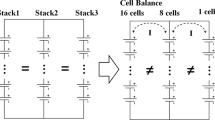Abstract
Since the state-of-charge (SOC) based balancing can prolong the battery pack’s life and maximize its capacity, implementing the balancing process in the battery management system (BMS) can explicitly reduce the cost of the battery based energy-storage-system (ESS). With the same initial SOC distribution, different balancing topologies may lead to different amounts of energy transferred in the balancing process due to the energy transferring efficiency of equalizers. Furthermore, the more energy equalizers transfer, the more energy and time balancing process will consume. Thus, instead of solely minimizing the balancing time for balancing optimization, it is critical to take into account the energy dissipation of balancing process. This paper presents a novel balancing optimization method from the perspective of minimizing the energy dissipation of balancing process. First, we introduce a two-step balancing strategy in the fast charging system. This strategy can simplify the modular design of the balancing system, and ensure the safety performance of the fast charging system while maximizing the balancing current. Second, an effective system modeling method is proposed for different balancing topologies. With different initial SOC distributions, we simulate the energy dissipation for different balancing topologies. Simulation results are presented to show that the cascade and cascade-series connection topologies would achieve a balanced state in the optimal energy dissipation.






















Similar content being viewed by others
References
Baronti F, Roncells R, Saletti R (2014) Performance comparison of active balancing techniques for lithium-ion batteries. J Power Sources 267:603–609
Cassani PA, Williamosn SS (2009) Feasibility analysis of a novel cell equalizer topology for plug-in hybrid electric vehicle energy-storage systems. IEEE Trans Veh Technol 58(8):3938–3946
Daowd M, Omar N, Bossche PVD, Mierlo JV (2011) Passive and active battery balancing comparison based on MATLAB simulation. In: Proceedings of the IEEE Veh. Power Propulsion Conf., Chicago, IL, USA, pp 1–7
Einhorn M, Roessler W, Fleig J (2011) Improvd performance of serially connected Li-ion batteries with active cell balancing in electric vehicles. IEEE Transactions on Vehicular Technologies 60:2448–2457
Gallardo-Lozano J, Romero-Cadaval E, Milanes-Montero MI, Guerrero-Martinez MA (2014) Battery equalization active methods. J Power Sources 246:934–949
Lee Y-S, Cheng M-W (2005) Intelligent control battery equalization for series connected lithium-ion battery strings. IEEE Trans Ind Electron 52(5):1297–1307
Lim CS, Lee KJ, Ku NJ, Hyun DS, Kim RY (2014) A modularized equalization method based on magnetizing energy for a series-connected Lithium-ion battery string. IEEE Trans Power Electron 29(4):1791–1799
McCurlie L, Preindl M, Emadi A (2017) Fast model predictive control for redistributive lithium ion battery balancing. IEEE Trans Industrial Electronics 64(2):1350–1357
Nguyen N, Oruganti SK, Na K, Bien F (2014) An adaptive backward control battery equalization system for serially connected lithium-ion battery packs. IEEE Trans Veh Technol 63(8):3651–3660
Nguyen TTN, Yoo HG, Oruganti SK, Bien F (2015) Neuro-fuzzy controller for battery equalisation in serially connected lithium battery pack. IET Power Electron 8(3):458–466
Ouyang Q, Chen J, Liu H, Fang H (2017) Improved cell equalizing topology for serially connected lithium-ion battery packs. IEEE Trans Ind Appl 53(3):2369–2381
Ouyang Q, Chen J, Zheng J, Hong Y (2017) SOC Estimation-based quasi-sliding mode control for cell balancing in Lithium-ion battery packs. IEEE Trans Ind Electron 65(4):3427–3436
Ouyang Q, Chen J, Zheng J, Fang H (2018) Optimal Cell-to-Cell balancing topology design for serially connected Lithium-ion battery packs. IEEE Trans Sustainable Energy 9(1):350–360
Plett GL (2004) Extended Kalman filtering for battery management systems of liPB-based HEV battery packs: Part 2. Modeling and identification. J Power Sources 134(2):262–276
Acknowledgment
We thank our colleagues from KETI and KEIT who provided insight and expertise that greatly assisted the research and greatly improved the manuscript. This work is supported by the Industrial Core Technology Development Program of MOTIE/KEIT, KOREA. [#10083639, Development of Camera-based Real-time Artificial Intelligence System for Detecting Driving Environment & Recognizing objects on Road Simultaneously]
Author information
Authors and Affiliations
Corresponding author
Additional information
Publisher’s Note
Springer Nature remains neutral with regard to jurisdictional claims in published maps and institutional affiliations.
Rights and permissions
About this article
Cite this article
Zhang, Y., Hong, Y. & Choi, K. Optimal energy-dissipation control for SOC based balancing in series connected Lithium-ion battery packs. Multimed Tools Appl 79, 15923–15944 (2020). https://doi.org/10.1007/s11042-018-6655-4
Received:
Revised:
Accepted:
Published:
Issue Date:
DOI: https://doi.org/10.1007/s11042-018-6655-4




